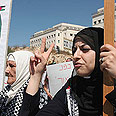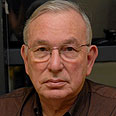Statistics tables don't make for great reading, but sometimes they can be a lot more juicy than textual theories.
Yaron London is a regular columnist for Yedioth Ahornoth, Israel's leading newspaper"Arab Society in Israel," a new book edited by Aziz Haidar and published recently by the Van Leer Institute and United Kibbutz Publishing, contains a mountain of stats. Some contradict many preconceived notions about this "sector," others reinforce the sharp discrimination suffered by a fifth of Israeli citizens that we've long known about.
There you go, I've made a very popular mistake, right there in my last sentence. "A fifth of Israeli citizens." In fact, Arab Israelis make up just over 15 percent of the country's population.
According to the most recent numbers from the Central Bureau of Statistics (2001), there are 957,000 Israeli Arabs, not including Jerusalem Arabs, who aren't citizens. And even if we include Jerusalem Arabs, the Arab percentage of Israel's citizenry wouldn't pass one-sixth.
This mistake is often used as a weapon in the "demographic debate" current in our society.
Challenging assumptions
I've also chosen a few stats to challenge existing assumptions. For instance, the claim that removing Israeli jurisdiction from the "Arab triangle" would ease the "demographic problem."
Many people know that Knesset candidate Avigdor Lieberman proposes just such a plan, one that is sure to gain him many votes from simple people who like simple, strong solutions.
Even without addressing the moral or legal angles of such a plan, the numbers alone show its futility.
Some 220,000 people live in the "triangle," including tens of thousands in villages such as Tira and Kfar Kara that would be impossible to cut off, due purely to geographic reasons.
And would the rest of the Arabs in the area agree to cut their ties to Israel, even if they were generously compensated? One need only look at one more statistic to figure out the answer: Some 57 percent of Arab men work outside their villages. They are unlikely to willingly trade their sources of income for a life of poverty.
Demographically, too, the numbers show that cutting the triangle off from Israel would yield minimal demographic benefit. There are 115,000 Arabs in the Negev, reproducing at a rate twice that of their co-nationalists in other parts of the country.
If this trend continues, "Triangle Arabs" will quickly become a small percentage of Israeli Arabs, and Lieberman will be forced to draw yet another border in the south.
Another statistic, this time regarding Arab productivity: Arab unemployment rates are slightly below Jewish ones, but the surprising fact is that amongst Arabs with higher education the percentage of unemployed is much lower than educated Jews: 1.7 percent, as opposed to 4.6 percent of Jews.
Even more surprising is that the number of employed, educated Arab women is significantly higher than the number of employed, educated Jewish women.
The rash conclusion is that raising the number of university-educated Arabs is a more worthwhile economic investment than amongst Jews.
Sharp discrimination
But the truth of the matter is that low unemployment amongst educated Arabs derives in (large) part from their willingness to do jobs Jews refuse to do, teaching in particular.
The relegation of educated Arabs to these professions derives from sharp discrimination in the workplace, which finds expression in the next shocking statistic: Arabs are almost completely absent from the highest paid sectors on the job market: electricity and water, banking, finance, global economic organizations. Just 1.8 percent of Arabs work in these areas.
And to top it all off, another stat: If I would ask you (or myself, before reading the book) whether Jews or Arabs were likely to be married, I think most people would answer confidently: Jews are much more likely to be single. Nope.
Amongst 30-34-year-olds, 17.4 percent of Arabs are single, as opposed to 13.2 percent of Jews. From 33-44, its even greater (13 percent to seven). And 60-year-old Muslims are some four times more likely to be single than Jews, a phenomenon researchers simply cannot understand.
Aziz Haidar's book is an important work, but we must hope that there are no more books like it in future, because Israel's Arab citizens will be considered just part of the overall makeup of Israel.

















